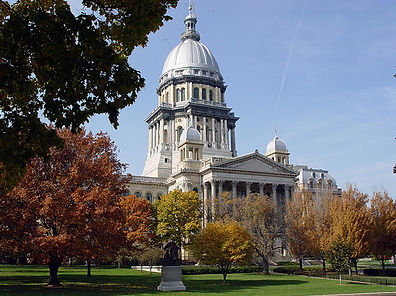
The History of Springfield, Illinois
Springfield's original name was Calhoun, after Senator John C. Calhoun of South Carolina. The land that Springfield now occupies was originally settled by trappers and traders who came to theSangamon River in 1818. The settlement's first cabin was built in 1820, by John Kelly, its site is at the northwest corner of Second Street and Jefferson Street. In 1821, Calhoun became the county seat of Sangamon County; due to the fertile soil, and trading opportunities. Settlers from Kentucky,
Virginia, and as far as North Carolina came to the city. By 1832, Senator Calhoun had fallen out of the favor with the public and the town renamed itself Springfield after Springfield, Massachusetts. At that time, Springfield, Massachusetts was comparable to modern-day Silicon Valley—known for industrial innovation, concentrated prosperity, and the celebrated Springfield Armory. Most importantly, it was a city that had built itself up from frontier outpost to national power through ingenuity - an example that the newly named Springfield, Illinois, sought to emulate.
Kaskaskia was the first capital of the Illinois Territory from its organization in 1809, continuing through statehood in 1818, and through the first year as a state in 1819. Vandalia was the second state capital of Illinois from 1819 to 1839. Springfield became the third and current capital of Illinois in 1839. The designation was largely due to the efforts of Abraham Lincoln and his associates; nicknamed the "Long Nine" for their combined height of 54 feet (16 m)
The American Civil War made Springfield a major center of activity. Illinois regiments trained there, the first ones under Ulysses S. Grant, who marched his soldiers to a remarkable series of victories in 1861–62. The city was a political and financial center of support, and new industries, businesses, and railroads were constructed to help support the war effort. The war's first official death was a Springfield resident, Colonel Elmer E. Ellsworth.
Camp Butler, seven miles (11 km) northeast of Springfield, Illinois, opened in August 1861 as a training camp for Illinois soldiers, but also served as a camp for Confederate prisoners of war through 1865. In the beginning, Springfield residents visited the camp to experience the excitement of a military venture, but many reacted sympathetically to mortally wounded and ill prisoners.
While the city's businesses prospered from camp traffic, drunken behavior and rowdiness on the part of the soldiers stationed there strained relations as neither civil nor military authorities proved able to control disorderly outbreaks.
After the war ended in 1865, Springfield became a major hub in the Illinois railroad system and besides politics and farming, coal mining was a major industry for Springfield by 1900




